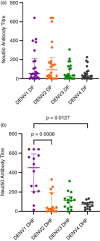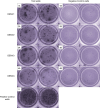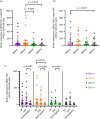Antibody and memory B cell responses to the dengue virus NS1 antigen in individuals with varying severity of past infection
- PMID: 37075785
- PMCID: PMC11495261
- DOI: 10.1111/imm.13651
Antibody and memory B cell responses to the dengue virus NS1 antigen in individuals with varying severity of past infection
Abstract
To further understand the role of NS1-specific antibodies (Abs) in disease pathogenesis, we compared neutralizing antibody levels (Nabs), NS1-Ab levels, IgG antibody subclass profiles and NS1-specific memory B-cell responses (Bmems) in individuals, with varying severity of past dengue. Nabs (Neut50 titres) were assessed using the Foci Reduction Neutralization Test (FRNT) and in-house ELISAs were used to assess NS1-Abs and NS1-Ab subclasses for all four DENV serotypes in individuals with past DF (n = 22), those with past DHF (n = 14) and seronegative (SN) individuals (n = 7). B-cell ELISpot assays were used to assess NS1-specific Bmem responses. 15/22 (68.18%) individuals with past DF and 9/14 (64.29%) individuals with past DHF had heterotypic infections. Neut50 titres were found to be significantly higher for DENV1 than DENV2 (p = 0.0006) and DENV4 (p = 0.0127), in those with past DHF, whereas there was no significant difference seen in titres for different DENV serotypes in those with past DF. Overall NS1-Ab to all serotypes and NS1-specific IgG1 responses for DENV1, 2 and 4 serotypes were significantly higher in those with past DHF than individuals with past DF. Those with past DHF also had higher IgG1 than IgG3 for DENV1 and DENV3, whereas no differences were seen in those with past DF. Over 50% of those with past DF or DHF had NS1-specific Bmem responses to >2 DENV serotypes. There was no difference in the frequency of Bmem responses to any of the DENV serotypes between individuals with past DF and DHF. Although the frequency of Bmem responses to DENV1 correlated with DENV1-specific NS1-Abs levels (Spearman r = 0.35, p = 0.02), there was no correlation with other DENV serotypes. We found that those with past DF had broadly cross-reactive Nabs, while those with past DHF had higher NS1-Ab responses possibly with a different functionality profile than those with past DF. Therefore, it would be important to further evaluate the functionality of NS1-specific antibody and Bmem responses to find out the type of antibody repertoire that is associated with protection against severe disease.
Keywords: B-cell ELISpots; NS1 antigen; antibodies; dengue; dengue fever; disease severity; neutralizing antibodies.
© 2023 The Authors. Immunology published by John Wiley & Sons Ltd.
Conflict of interest statement
The authors declare no conflicts of interest.
Figures





Similar articles
-
Phenotype and functionality of follicular helper T cells in patients with acute dengue infection.J Biomed Sci. 2020 Apr 8;27(1):50. doi: 10.1186/s12929-020-00641-2. J Biomed Sci. 2020. PMID: 32264870 Free PMC article.
-
Role of NS1 antibodies in the pathogenesis of acute secondary dengue infection.Nat Commun. 2018 Dec 7;9(1):5242. doi: 10.1038/s41467-018-07667-z. Nat Commun. 2018. PMID: 30531923 Free PMC article.
-
Dengue NS1-specific antibody responses: isotype distribution and serotyping in patients with Dengue fever and Dengue hemorrhagic fever.J Med Virol. 2000 Oct;62(2):224-32. doi: 10.1002/1096-9071(200010)62:2<224::aid-jmv14>3.0.co;2-c. J Med Virol. 2000. PMID: 11002252
-
The human antibody response to dengue virus infection.Viruses. 2011 Dec;3(12):2374-95. doi: 10.3390/v3122374. Epub 2011 Nov 25. Viruses. 2011. PMID: 22355444 Free PMC article. Review.
-
Progress towards understanding the pathogenesis of dengue hemorrhagic fever.Virol Sin. 2017 Feb;32(1):16-22. doi: 10.1007/s12250-016-3855-9. Epub 2016 Nov 14. Virol Sin. 2017. PMID: 27853992 Free PMC article. Review.
Cited by
-
Exploring the Contrasts and Similarities of Dengue and SARS-CoV-2 Infections During the COVID-19 Era.Int J Mol Sci. 2024 Oct 29;25(21):11624. doi: 10.3390/ijms252111624. Int J Mol Sci. 2024. PMID: 39519178 Free PMC article. Review.
References
-
- WHO . Ten threats to global health in 2019. Geneva: World Health Organization; 2019.
Publication types
MeSH terms
Substances
LinkOut - more resources
Full Text Sources
Medical
Miscellaneous

